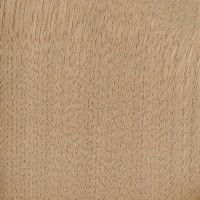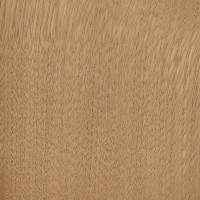Sweet Chestnut | The Wood Database (Hardwood) (original) (raw)
 Sweet Chestnut (Castanea sativa) Sweet Chestnut (Castanea sativa)  |
Common Name(s): Sweet Chestnut, Spanish Chestnut, European Chestnut Scientific Name: Castanea sativa Distribution: Europe and Asia Minor Tree Size: 100-120 ft (30-37 m) tall, 5-7 ft (1.5-2.0 m) trunk diameter Average Dried Weight: 37 lbs/ft3 (590 kg/m3) Specific Gravity (Basic, 12% MC): .50, .59 Janka Hardness: 680 lbf (3,010 N) Modulus of Rupture: 10,360 lbf/in2 (71.4 MPa) Elastic Modulus: 1,248,000 lbf/in2 (8.61 GPa) Crushing Strength: 6,360 lbf/in2 (43.8 MPa) Shrinkage: Radial: 4.2%, Tangential: 6.9%, Volumetric: 12.6%, T/R Ratio: 1.6 |
|---|
Color/Appearance: Heartwood is a light to medium brown, darkening to a reddish brown with age. Narrow sapwood is well-defined and is pale white to light brown.
Grain/Texture: Grain is straight to spiral or interlocked. With a coarse, uneven texture.
Endgrain: Ring-porous; 2-4 rows of large, exclusively solitary earlywood pores, numerous small latewood pores in dendritic arrangement; tyloses common; growth rings distinct; rays not visible without lens; apotracheal parenchyma diffuse-in-aggregates (short lines between rays).
Rot Resistance: Rated as durable to very durable, though susceptible to insect attack.
Workability: Overall easy to work with both hand and machine tools. Chestnut splits easily, so care must be taken in nailing and screwing the wood. Due to its coarse texture, turning is mediocre. Glues, stains, and finishes well.
Odor: No characteristic odor.
Allergies/Toxicity: Although severe reactions are quite uncommon, Sweet Chestnut has been reported as a sensitizer, causing skin irritation. See the articles Wood Allergies and Toxicity and Wood Dust Safety for more information.
Pricing/Availability: No data available.
Sustainability: This wood species is not listed in the CITES Appendices or on the IUCN Red List of Threatened Species.
Common Uses: Furniture, veneer, and carvings.
Comments: This tree is widely cultivated for the edible seeds which it produces.
None available.
Scans/Pictures: A special thanks to Steve Earis for providing the veneer sample of this wood species.
 Sweet Chestnut (sanded) Sweet Chestnut (sanded) |
 Sweet Chestnut (sealed) Sweet Chestnut (sealed) |
|---|